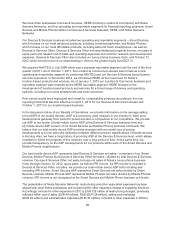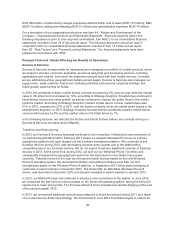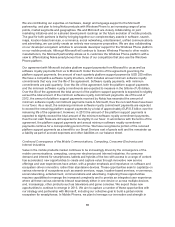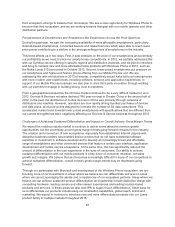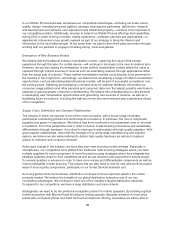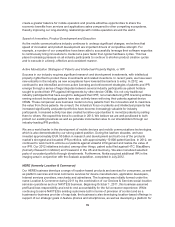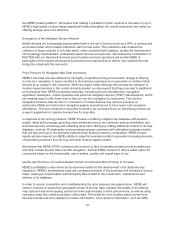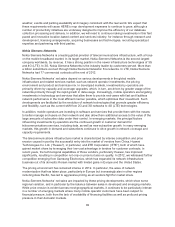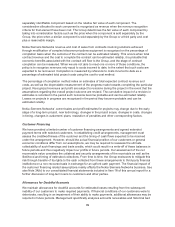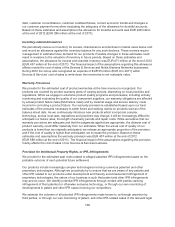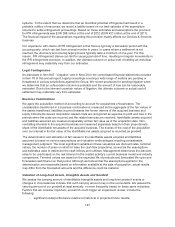Nokia 2012 Annual Report Download - page 93
Download and view the complete annual report
Please find page 93 of the 2012 Nokia annual report below. You can navigate through the pages in the report by either clicking on the pages listed below, or by using the keyword search tool below to find specific information within the annual report.weather, events and parking availability and imagery consistent with the real world. We expect that
these requirements will cause HERE’s map development expenses to continue to grow, although a
number of productivity initiatives are underway designed to improve the efficiency of our database
collection processing and delivery. In addition, we will need to continue making investments in this fast
paced and innovative location-based content and services industry, for instance through research and
development, licensing arrangements, acquiring businesses and technologies, recruiting specialized
expertise and partnering with third parties.
Nokia Siemens Networks
Nokia Siemens Networks is a leading global provider of telecommunications infrastructure, with a focus
on the mobile broadband market. In its target market, Nokia Siemens Networks is the second largest
company worldwide, by revenue. It has a strong position in the newer infrastructure technologies of 3G
and 4G (LTE). In 3G, Nokia Siemens Networks is the industry leader by customers served. More than
a billion subscribers connect through Nokia Siemens Networks’ 3G networks. In LTE, Nokia Siemens
Networks had 77 commercial contracts at the end of 2012.
Nokia Siemens Networks’ net sales depend on various developments in the global mobile
infrastructure and related services market, such as network operator investments, the pricing
environment and product and services mix. In developed markets, investments by operators are
primarily driven by capacity and coverage upgrades, which, in turn, are driven by greater usage of the
networks primarily through the rapid growth in data usage. Increasingly, mobile operators are targeting
investments in technology and services that allow them to provide end-users with fast and faultless
network performance in the most efficient manner possible, which optimizes their investment. Such
developments are facilitated by the evolution of network technologies that promote greater efficiency
and flexibility, such as the current shift from 2G and 3G networks to 4G (LTE) technologies.
In addition, mobile operators are investing in software and services that provide them with the means
to better manage end-users on their network and also allow them additional access to the value of the
large amounts of subscriber data under their control. In emerging markets, the principal factors
influencing investments by operators are the continued growth in customer demand for
telecommunications services, including data, as well as new subscriber growth. In many emerging
markets, this growth in demand and subscribers continues to drive growth in network coverage and
capacity requirements.
The telecommunications infrastructure market is characterized by intense competition and price
erosion caused in part by the successful entry into the market of vendors from China, Huawei
Technologies Co. Ltd. (“Huawei”), in particular, and ZTE Corporation (“ZTE”), both of which have
gained market share by leveraging their low-cost advantage in tenders for customer contracts. In
recent years, the technological capabilities of those vendors, particularly Huawei, has improved
significantly, resulting in competition not only on price but also on quality. In 2012, we witnessed further
competition emerging from Samsung Electronics, which has expanded its network infrastructure
business out of its domestic Korean market with limited gains in Europe and the United States.
The pricing environment has remained intense in 2012. In particular, the wave of network
modernization that has taken place, particularly in Europe but increasingly also in other regions
including Asia Pacific, has led to aggressive pricing as all vendors fight for market share.
Nokia Siemens Networks’ net sales are impacted by these pricing developments, which show some
regional variation, and in particular by the balance between sales in developed and emerging markets.
While price erosion is evident across most geographical markets, it continues to be particularly intense
in a number of emerging markets where many mobile operator customers have been subject to
financial pressure, both from the lack of availability of financing facilities as well as profound pricing
pressure in their domestic markets.
92


